Many of the most popular Garmin product series feature useful sleep tracking widgets that include advanced sleep monitoring metrics to help you achieve accurate sleep data. When it comes to athletics, sleep is one of the most important health necessities to achieve peak performance.
This is where a useful and detailed guide on all of the benefits of the Garmin Sleep Tracking Widget becomes necessary. So, what is the Garmin Sleep Tracking Widget?
Garmin’s sleep tracking widget can score your overall sleep patterns and rem sleep cycles each night. The advanced sleep monitoring asm protocol can measure heart rate variability, deep sleep stages, eye and muscle movements, and how your heart rate and breathing respond to rem sleep.
Are you curious about Garmin’s advanced sleep monitoring? Do you need more detailed information on how sleep tracking works and what the data means? If so, this comprehensive guide will tell you everything you need to know about Garmin Sleep Tracking Widgets.
We will explore the various sleep tracking and advanced sleep monitoring available on products in multiple Garmin series. Read on to find out more as we answer some of your frequently asked questions about Garmin sleep tracking.
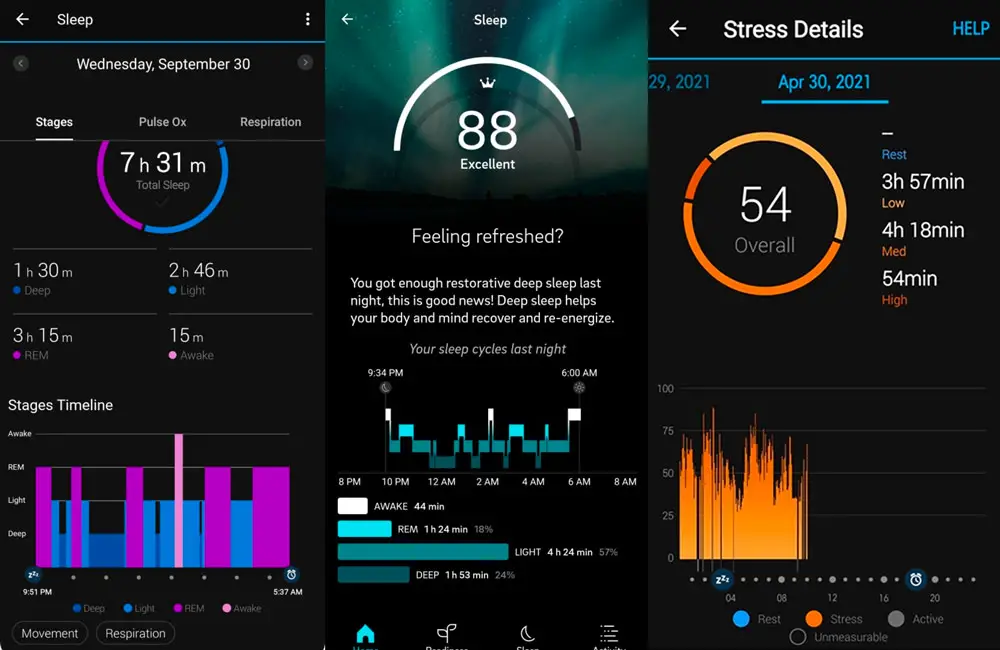
Do Garmin Devices Track Sleep?
There are many devices across various Garmin series that feature advanced sleep monitoring (ASM). With the Garmin sleep tracking widget, you don’t have to be an expert in sleep and its various phases as these clever tools do all the hard work for you.
Your Garmin sleep tracking device will analyze your heart rate variability during sleep. Additionally, your respiratory rate, how this compares to your heart rate variability, and your body movements and muscle activity during nap time are also recorded and scored upon waking.
Your device achieves this by immediately detecting which sleep phase you are currently at from light sleep to deep sleep, rem sleep, or even if you are awake without realizing it.
The sleep tracking device on your wrist watch will tell you the overall sleep quality in each phase. It does this by using a scoring system that uses scientific standards concerning the best type and amount of sleep based on your overall health statistics such as your age, gender, activity levels, etc.
- Garmin Venu SeriesFitness smartwatch with music
- Garmin Vivoactive SeriesGPS smartwatch with energy monitoring
- Garmin Vivomove SeriesFashion smartwatch
- Garmin Vivosmart SeriesActivity tracker with REM tracking
- Garmin Vivofit JuniorFitness tracker for kids
- Garmin Fenix SeriesAdvanced multisport watch
- Garmin Forerunner SeriesGPS running watches
The different sleep stages that Garmin tracks
Good sleep quality means that you have entered the restorative sleep cycle, which is usually found during periods of deep sleep. For example, if you sleep from 10 PM to 6 AM, this deep sleep cycle can typically be found during the hours of 2 AM-4 AM.
The hours of 10 PM-2 AM and 4 AM-6 AM would be known as light sleep. But you can only successfully enter deep sleep if you go through a light sleep cycle first which is typically when REM sleep occurs.
The final light sleep phase is also important as you would feel groggy and sluggish throughout the day if you were awakened immediately after deep sleep.
Through the comparison of the heart rate variability and the overall heart rate, you can know whether you have a good sleep quality when you are in bed.
This is due to the parasympathetic nervous system which is responsible for providing a good sleep quality through sleep responses based on muscle movements and muscle activity, eye movements and muscle responses. It also observes how eye and muscle movements stop completely when approaching deep sleep, which is why pressure will decrease the quality of sleep.
Considering your sleep quality, the physiological measurements, and the training data; your device will calculate your sleep score and provide you with advice based on the optimal sleep needed.
It is best to wear your watch all day to get a more accurate result since heart rate and breathing while awake will be needed to ensure an accurate comparison when you are sleeping.

The Meaning of Your Sleep Tracking Score
Upon waking, your score can be divided into 4 different levels: 100, 80-99, 50-79, and 0-49.
A score of 100 means you have a very good sleep. Your overall bedtime is enough, and the sleep you experienced is restorative sleep. Your body, brain, and even your immune system are all functioning at optimal capacity.
A score of 80-99 means that your sleep is mostly okay. In the 50-79 range, you had a moderate level of zzz’s, and you should be able to function adequately throughout the day, but not to the best of your ability. It is common to receive this score if you were awakened in the middle of the night or experienced multiple wake times during sleep stages.
A score of 0-49 means that your sleep quality is not good. You can expect to feel tired, lethargic, and most likely irritable, and unable to function adequately throughout the day. It is not a good idea to do physical activity on a day like this since your internal organs, brain, and even your immune system have not been adequately restored and refreshed.
Try to track your sleep every day with your device and gradually adjust your sleep in a healthy way based on the scoring data and metrics you receive.
How to Improve Your Score
With the accurate sleep data you receive, the reason your score may be low most of the time is that your waking time is over 20% or you have over 80% of light sleep.
Besides, if your bedtime is less than 5 hours, no matter how good the sleep quality you have, your sleep will still be seen as insufficient. Therefore, the keys to improving your sleep score are to increase your bedtime and to improve your sleep quality, especially if you have exercised vigorously during the day.
Be sure to log off all devices such as phones and computers at least 30 minutes before you go to bed. Make sure you sleep in a dark and atmospherically comfortable environment. Light, either sunlight or artificial light, will disrupt your circadian rhythm and affect sleep eye movements and rem sleep.
Which Garmin Watches Track Sleep and Which One Is Best?
Nearly every Garmin series features sleep tracking on many models found within the series. Let’s take a look at each of the best models in each series to discover which watch is the best overall for sleep tracking.
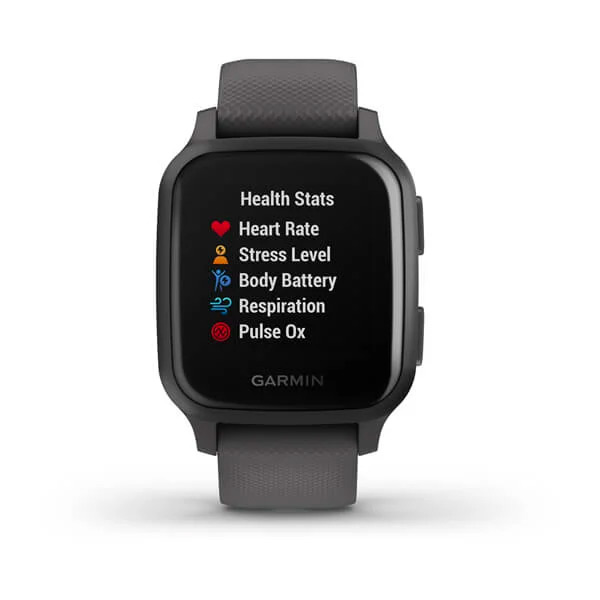
Garmin Venu Series
The Garmin Venu series was designed to include many useful activity-tracking features, one of which is a sleep tracking feature found on many models in the series.
Of all the Venu models that feature sleep tracking, the Garmin Venu Sq is the best.
The Venu Sq allows you to get a full picture of how you’re sleeping while paired with your compatible smartphone, with a breakdown of your estimated light, deep, and REM sleep stages as well as estimated Pulse Ox and respiration data.
Another great feature of this model when you want to relax or focus, is how you can start a breath-work activity, and this watch will track your stress and respiration to help you get a better understanding of how you’re breathing.
In addition to sleep tracking, the Garmin Venu Sq also tracks and scores stress levels based on respiration and heart rate as well as providing you with a ‘Body Battery’ score that is a visual representation of how much energy you have left each day.
The Garmin Venu Sq is one of the older sleep tracking models in the Garmin line, and users frequently complained about inaccuracies with sleep track data when the watch was first released. However, improvements have been made to the latest model since its release to better align with many newer Garmin models.

Garmin Vivoactive Series
Like the Venu Series, the Garmin Vivoactive Series is designed to be compact and less bulky on the wrist.
You can find sleep track across each model in the series, but the Garmin Vivoactive 4 is likely the best model in terms of the ease of using the device’s features.
While you are sleeping, the device automatically detects your sleep and monitors your movement during your normal sleep hours.
You can set your normal sleep hours in the user settings on your Garmin Connect app. Sleep statistics include total hours of sleep, sleep levels, and sleep movement.
You can also view your sleep statistics on your Garmin Connect app if you want a more detailed analysis beyond the widget display.
It also tracks your heart rate variability (HRV), which is used to calculate and track your stress level. The Vivoactive 3 can make you aware when physical or emotional sources cause your stress level to rise, so that you can find a way to relieve the pressure.
The sleep feature on the Vivoactive 3, and indeed all watches with the Vivoactive series, are very similar to the Venu series, and any inaccuracies are likely due to forgetting to set your preferences in the app.

Garmin Vivomove Series
The Garmin Vivomove Series is designed to be both affordable and fashionable for those who do not wish to purchase a more athletic-heavy Garmin device.
In terms of sleep scoring, the Garmin Vivomove HR is a good option thanks to the device’s concentration on measuring both stress and sleep.
You most likely experience stress at some point in your day, but how much? The great thing about the Vivomove HR device is that it lets you know when you are having a calm, balanced or stressful day, thanks to all-day stress tracking- even while you are sleeping!
If your stress level gets elevated during your day, you’ll know it’s time to take a break and maybe fend off a headache or other physical symptoms, which is also essential for ensuring that you do not take this stress with you at bedtime.
You can use the relaxation timer on the Vivomove HR to work through a deep breathing exercise and lower your stress. All of the typical sleep tracking features that Garmin offers are intact, and this is an added bonus since you can now see if you are suffering from sleep imbalances due to stress.

Garmin Vivosmart Series
The Garmin Vivosmart series is similar to Fitbit in that these models are purely activity trackers as opposed to smartwatches.
For sleep tracking, the Garmin Vivosmart 4 offers a great way to optimize sleep if you do not wish to purchase a watch with additional features that you do not need.
To give you an idea of how you’re sleeping, the Vivosmart 4 tracks your light, deep, and REM stages of sleep, along with movement throughout the night.
For added insight, you can also turn on the pulse ox feature to view your blood oxygen levels during your sleep. When you wake up, you can easily review and compare your sleep stats in the Garmin Connect app.
Some users complain of some wrist discomfort with the Vivosmart series, but if you only wish to use the device to track sleep, this should not be an issue.
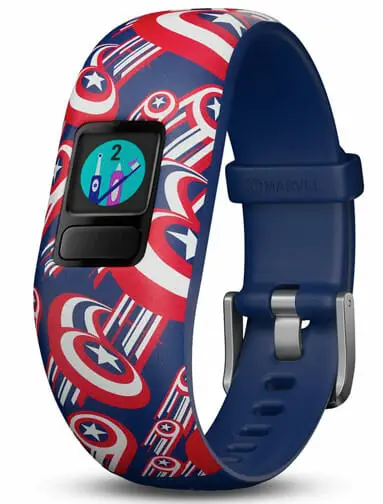
Garmin Vivofit Junior
You may think it is uncommon for kids to experience sleep disturbances or imbalances, but it is actually quite common due to the high energy levels that children experience.
Garmin has a line of activity trackers designed for kids known as the Garmin Vivofit Junior series. These devices are wrist wearables and feature activity trackers that are coded to record statistics compared across optimal child health, including a sleep tracking feature.
The Vivofit Junior sleep tracker can be managed by parents using the compatible app.
From the app, you can observe and track all of your child’s sleeping patterns much in the same way as the features available on adult Garmin devices.
A convenient feature of the Vivofit Junior is that you can see and monitor the data since it automatically syncs to your smartphone.
This device is compatible with children aged between 4-9 years of age and is available in many different colorful design styles.
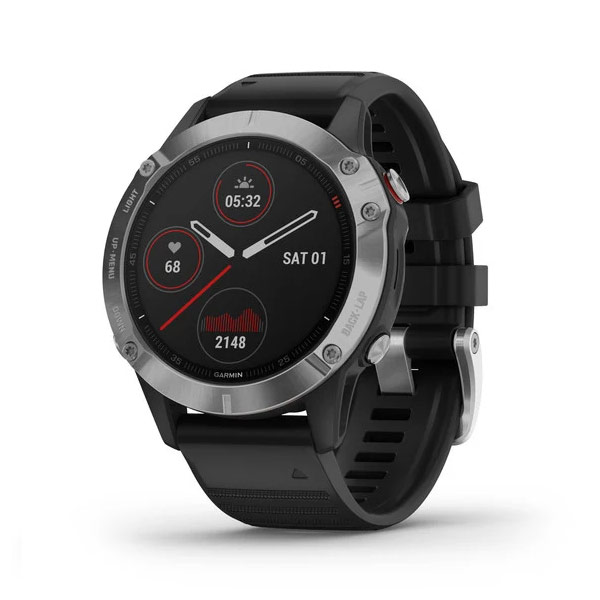
Garmin Fenix Series
The Garmin Fenix Series remains one of Garmin’s most popular series in terms of GPS smartwatches and activity trackers. Many models in the Fenix line also come with sleep trackers.
One model in the Fenix Series to consider is the Garmin Fenix 6S. This model is a bit expensive, but the added feature of a body battery energy monitor that also takes into account your stress levels when compared to sleep irregularities makes this model a standout in terms of tech innovation with sleep tracking.
With the Fenix 6S, you can get estimated heart rate data along with alerts if your heart rate stays too high or too low while you’re at rest. You can also gauge how hard your heart is working during a wide range of other physical activities as well.
The body battery energy monitor allows you to optimize your body’s energy reserves, using heart rate variability, stress, sleep, and other data to gauge when you’re ready to be active or when you may need to rest if you are experiencing sleep problems.
The Garmin Fenix 6S is pricey, but if you want one of the more advanced and multi-faceted Garmin sleep trackers, this model is worth considering.
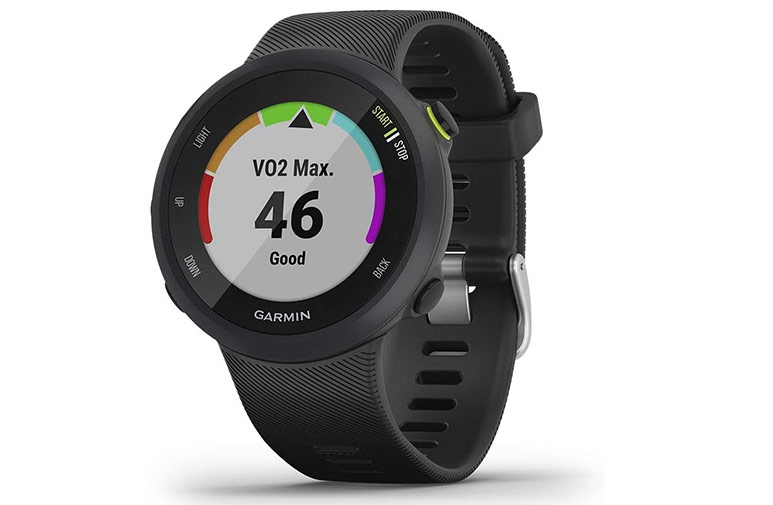
Garmin Forerunner Series
The Garmin Forerunner Series was one of the first Garmin lines created for runners and triathletes. Many watches within the Forerunner line also feature sleep tracking, and this feature is comparable to all sleep tracking features on Garmin devices.
Your sleep duration and how long you slept in each of the sleep stages are recorded and reflected on both the widget and on the sleep card within Garmin Connect.
Of all the models in the Garmin Forerunner line, the Forerunner 945 is consistently ranked as the most popular model in the Forerunner line.
For sleep tracking, the Forerunner 945 features an estimated wrist-based heart rate and a wrist-based pulse ox sensor that monitors blood oxygen saturation levels to support advanced sleep monitoring and altitude acclimation as well.
For a more affordable option, the Garmin Forerunner 45 also features the same sleep tracking features for a fraction of the cost.
If you want more activity tracking overall, the Forerunner 945 is a great option, but you can always choose the Forerunner 45 if you are only interested in sleep tracking.
Which Sleep Tracking Device Is Best?
With so many options to choose from throughout multiple Garmin series, the final decision on which sleep tracking device is best comes down to overall cost, design type, and if you are interested in any of the above-listed models that include advanced sleep-tracking features.
If you are only wanting a sleep tracking device and do not need any of the other activity tracking features that can be found on many Garmin models, opting for the Garmin Forerunner 45 or the Garmin Venu Sq are the best options.
In terms of the design type, the basic sleep tracking wearables are small and lightweight, but these models can sometimes cause wrist burn or discomfort if you choose to use the device for both activity tracking and sleep tracking.
Additionally, many of the watches listed can be a bit bulky, which may not be an optimal experience when you are sleeping. But a plus is that many of these models feature pulse ox monitoring, which can greatly add to the sleep data available after you wake up.
But the best point of interest in choosing the best sleep tracker comes down to both the Garmin Vivomove HR and the Garmin Fenix 6S.
Both of these models feature advanced heart rate monitoring features in addition to added benefits that add more data to your overall sleep patterns.
The Vivomove HR lets you know when you are having a calm, balanced or stressful day and everything in between thanks to all-day stress tracking-even while you are sleeping.
The Garmin Fenix 6S features a body battery energy monitor that allows you to optimize your body’s energy reserves, using heart rate variability, stress, sleep, and other data to gauge when you’re ready to be active or when you may need to rest if you are experiencing sleep problems.
Based on the innovation found with the body battery energy monitor in the Fenix 6S, this is the best model overall to consider.
FAQs
What does REM mean on Garmin sleep?
The REM sleep function can use a heart rate monitor to help you grasp your sleep cycle better. The data is displayed in a color-coded format that represents each stage in your sleep cycle, and how long it takes in your sleep process. All of this data is stored and can be checked through Garmin Connect.
How does the Garmin sleep widget work?
How do I get my Garmin to track sleep?
Can you use the optical heart rate sensor during advanced sleep monitoring?
Make sure the Garmin Connect app is up-to-date and make sure you wear your device at least two hours before bedtime and two hours during sleep.
How does my Garmin watch know I’m sleeping?
How accurate is Garmin’s sleep tracking?
But even with the limited amount of data provided, the results are accurate and allow users to gain an overview of their sleeping patterns – if not a full-on scientific analysis.
Why isn’t my Garmin tracking my sleep through Garmin Connect?
Make sure all of these details are in place in order to get accurate recordings.
What to do when your Garmin sleep tracking isn’t working
Most of the time, sleep data is not recorded since one of these features is likely not enabled. It is typically best to activate the sleep tracker manually on the widget. Be sure to wear the device while sleeping.
Garmin vs Fitbit sleep tracking – which one is better?
Is a sleep tracker safe to wear?
How much sleep is normal?
On the flip side, those who consistently sleep longer than 10 hours per night may need to be checked for a possible sleep disorder, in addition to those who simply cannot sleep at least 7 hours per night.
How do you turn on the pulse ox sleep tracking feature?
Final Thoughts
In summary, the Garmin Sleep Tracking Widget can be found on many different Garmin devices to the point that it is commonplace now.
This is a great way to gauge your overall sleeping patterns in order to achieve optimal health and to ensure that you are able to do physical activity without easily tiring the next day.
If you wake up a lot during the middle of the night, the statistics that are recorded can even help you better understand how this affects your overall sleep quality.
Related articles:
- Garmin Enduro GPS Smartwatch Review
- Which Garmin GPS Watch Is Best for You?
- Garmin vs Apple Watch – Which Brand Is Best for Multisports Tracking?
Sources: https://www.garmin.com/en-US/blog/health/garmin-health-announces-sleep-study-results/
